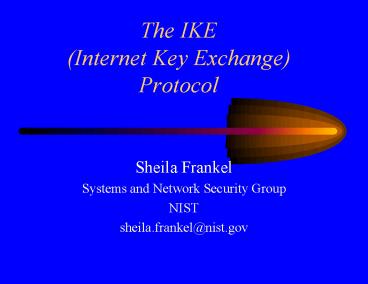The IKE (Internet Key Exchange) Protocol - PowerPoint PPT Presentation
1 / 24
Title:
The IKE (Internet Key Exchange) Protocol
Description:
Internet Security Association and Key Management Protocol (ISAKMP) RFC 2408 ... Generators (One and Two) Curves (A and B) Order. Key Mgmt Wkshp - Feb. 10, 2000. 9 ... – PowerPoint PPT presentation
Number of Views:523
Avg rating:3.0/5.0
Title: The IKE (Internet Key Exchange) Protocol
1
The IKE (Internet Key Exchange) Protocol
- Sheila Frankel
- Systems and Network Security Group
- NIST
- sheila.frankel_at_nist.gov
2
IKE Overview
- Negotiate
- Communication Parameters
- Security Features
- Authenticate Communicating Peer
- Protect Identity
- Generate, Exchange, and Establish Keys in a
Secure Manner - Manage and Delete Security Associations
3
IKE Overview (continued)
- Threat Mitigation
- Denial of Service
- Replay
- Man in Middle
- Perfect Forward Secrecy (PFS)
- Usable by IPsec and other domains
4
IKE Overview (continued)
- Components
- Internet Security Association and Key Management
Protocol (ISAKMP) - RFC 2408
- Internet Key Exchange (IKE)
- ltdraft-ietf-ipsec-ike-01.txtgt
- Oakley Key Determination Protocol
- RFC 2412
- IPSec Domain of Interpretation (IPsec DOI)
- RFC 2407
5
Constructs Underlying IKE
- Security Association (SA)
- Security Association Database (SAD)
- Security Parameter Index (SPI)
6
IKE Negotiations - Phase 1
- Purpose
- Establish ISAKMP SA (Secure Channel)
- Steps (4-6 messages exchanged)
- Negotiate Security Parameters
- Diffie-Hellman Exchange
- Authenticate Identities
- Main Mode vs. Aggressive Mode vs. Base Mode
7
Phase 1 Attributes
- Authentication Method
- Pre-shared key
- Digital signatures (DSS or RSA)
- Public key encryption (RSA or El-Gamal)
- Group Description (pre-defined)
- Group Type (negotiated)
- MODP (modular exponentiation group)
- ECP (elliptic curve group over GFP)
- EC2N (elliptic curve group over GF2N)
8
Phase 1 Attributes (continued)
- MODP Group Characteristics
- Prime
- Generator
- EC2N Group Characteristics
- Field Size
- Irreducible Polynomial
- Generators (One and Two)
- Curves (A and B)
- Order
9
Phase 1 Attributes (continued)
- Encryption algorithm
- Key Length
- Block size
- Hash algorithm
- Life duration (seconds and/or kilobytes)
10
IKEs Pre-Defined Groups
- MODP
- Prime 768-bit, 1024-bit, 1536-bit
- Generator 2
- EC2N
- GF2155, GF2185
- GF2163 (2 groups), GF2283 (2 groups)
11
Main ModeAuthentication with Pre-Shared Keys
HDR contains CKY-I CKY-R KE gi (Initiator)
or gr (Responder)
12
Main ModeAuthentication with Digital Signatures
HDR contains CKY-I CKY-R KE gi (Initiator)
or gr (Responder) SIG_I/SIG_R digital sig of
HASH_I/HASH_R
13
Main ModeAuthentication with Public Key
Encryption
HDR contains CKY-I CKY-R KE gI (Initiator)
or gr (Responder)
14
Main Mode Authentication with Revised Public
Key Encryption
HDR contains CKY-I CKY-R KE gI (Initiator)
or gr (Responder) Ke_i/r symmetric key from
Ni/r_b and CKY_I/R
15
Key Derivation
- SKEYID
- Pre-shared keys
- HMAC_H(pre-shared-key, Ni_b Nr_b
- Digital signatures
- HMAC_H(H(Ni_b Nr_b), gir)
- Public key encryption
- HMAC_H(H(Ni_b Nr_b), CKY-I CKY-R)
16
Key Derivation (continued)
- SKEYID_d (used to derive keying material for
IPsec SA) - HMAC_H(SKEYID, gir CKY-I CKY-R 0)
- SKEYID_a (auth key for ISAKMP SA)
- HMAC_H(SKEYID, SKEYID_agirCKY-ICKY-R1)
- SKEYID_e (enc key for ISAKMP SA)
- HMAC_H(SKEYID, SKEYID_agirCKY-ICKY-R2)
17
Hash Calculations
- HASH_I
- HMAC_H(SKEYID, gi gr CKY-I CKY-R Sai_b
ID_i1_b) - HASH_R
- HMAC_H(SKEYID, gr gi CKY-R CKY-I Sai_b
ID_r1_b)
18
IKE Negotiations - Phase 2
- Purpose
- Establish IPsec SA
- Steps (3-4 messages exchanged)
- Negotiate Security Parameters
- Optional Diffie-Hellman Exchange (for PFS)
- Optional Exchange of Identities
- Final Verification
- Quick Mode
- New Groups Mode
19
Phase 2 Attributes
- Group description (for PFS)
- Encryption algorithm (if any)
- Key length
- Key rounds
- Authentication algorithm (if any)
- Life duration (seconds and/or kilobytes)
- Encapsulation mode (transport or tunnel)
20
Quick Mode
HDR contains CKY-I CKY-R KE (for PFS) gI
(Initiator) or gr (Responder)
21
Key Derivation
- KEYMAT (no PFS)
- HMAC_H(SKEYID_d, protocol SPI Ni_b Nr_b)
- KEYMAT (with PFS)
- HMAC_H(SKEYID_d, gir (QM) protocol SPI
Ni_b Nr_b) - Expanded KEYMAT (if needed)
- K2 HMAC_H(SKEYID_d, KEYMAT gir (QM)
protocol SPI Ni_b Nr_b) - K3 HMAC_H(SKEYID_d, K2 gir (QM)
protocol SPI Ni_b Nr_b) etc.
22
Hash Calculations
- HASH(1)
- HMAC_H (SKEYID_a Message_ID contents of
Message 1) - HASH(2)
- HMAC_H (SKEYID_a Message_ID Ni_b contents
of Message 2) - HASH(3)
- HMAC_H (SKEYID_a 0 Message_ID Ni_b Nr_b)
23
New Groups Mode
24
Contact Information
- For further information, contact
- Sheila Frankel sheila.frankel_at_nist.gov































